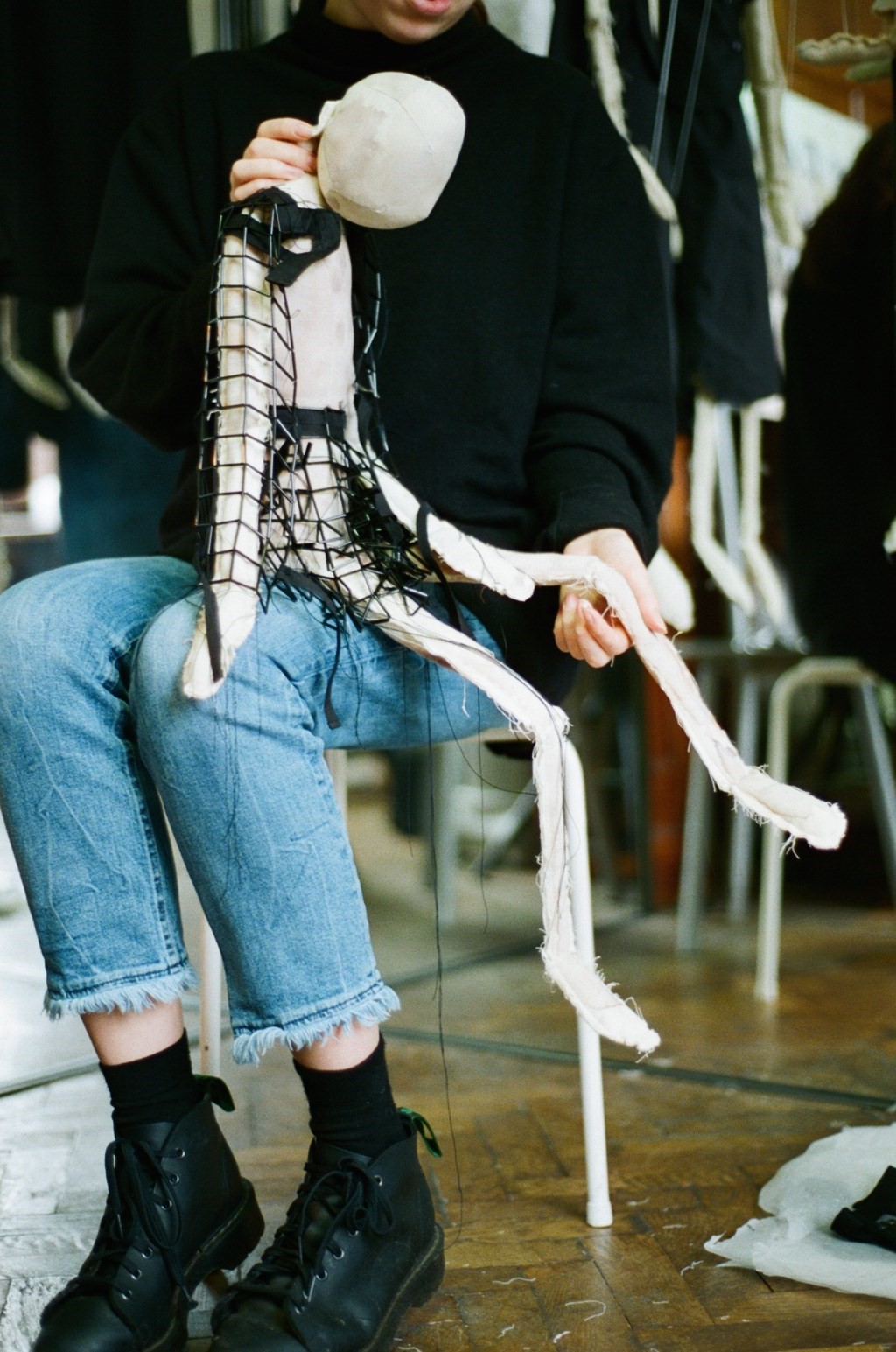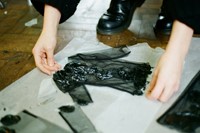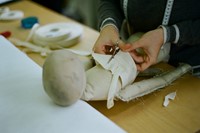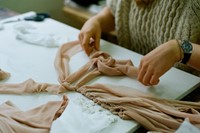Phoebe English works from a rambling network of artists’ studios on an industrial side-street in Deptford. On a foggy morning I sit and wait for the designer to finish up some last-minute prep in the next room, eyeing with trepidation four puppets dangling ominously in one corner.
The puppets are dressed in miniature versions of key pieces from across English’s six-year career – tulle painted with thick daubs of T-shirt ink, or little layered shirts and jackets at around one-third of life-size. 28 of these puppets will accompany real-life models in highlights from the designer’s career at today’s Fashion in Motion presentation at the Victoria and Albert Museum.
“They’re inanimate, but they are alive,” says English cheerfully once she settles herself. “I think that’s one of the things I really enjoy about working with them. A lot of the work I do is about trying to reach that duality of things: chaos and control, for instance. Clean surfaces and hectic ones. Trying to get at that conversation between things.I think that’s part of the draw to the puppets.”
In the years since she graduated from the MA in Fashion at Central Saint Martins and established her own brand, English has tried to avoid the run-of-the-mill catwalk show. Instead she’s opted for a process of constant collaboration, with set designers, filmmakers and musicians, to find the best way to present her work to the world. These immersive, intelligent shows suit the feel of her collections, too – thoughtful clothes, textures and silhouettes that can sometimes deceive the eye or demand a closer look. The impulse towards the live moment, she says, stems from a lifelong love of the theatre. “I was hoping to become an actress from when I was quite young. It didn’t work out and I did fashion as a kind of back-up. So performative structures are something that I’m always interested in.” Situating her work in the context of the V&A feels natural in a way, and in recent years designers as varied as Grace Wales Bonner and Kansai Yamamoto have presented as part of the Fashion in Motion programme. It’s a democratic format, overseen by curator Oriole Cullen, and the shows are free and open to anybody.
“The V&A is a place that I’m really very fond of, and a lot of my realisations of what I wanted to do happened in that building. It was a very personal moment for me” – Phoebe English
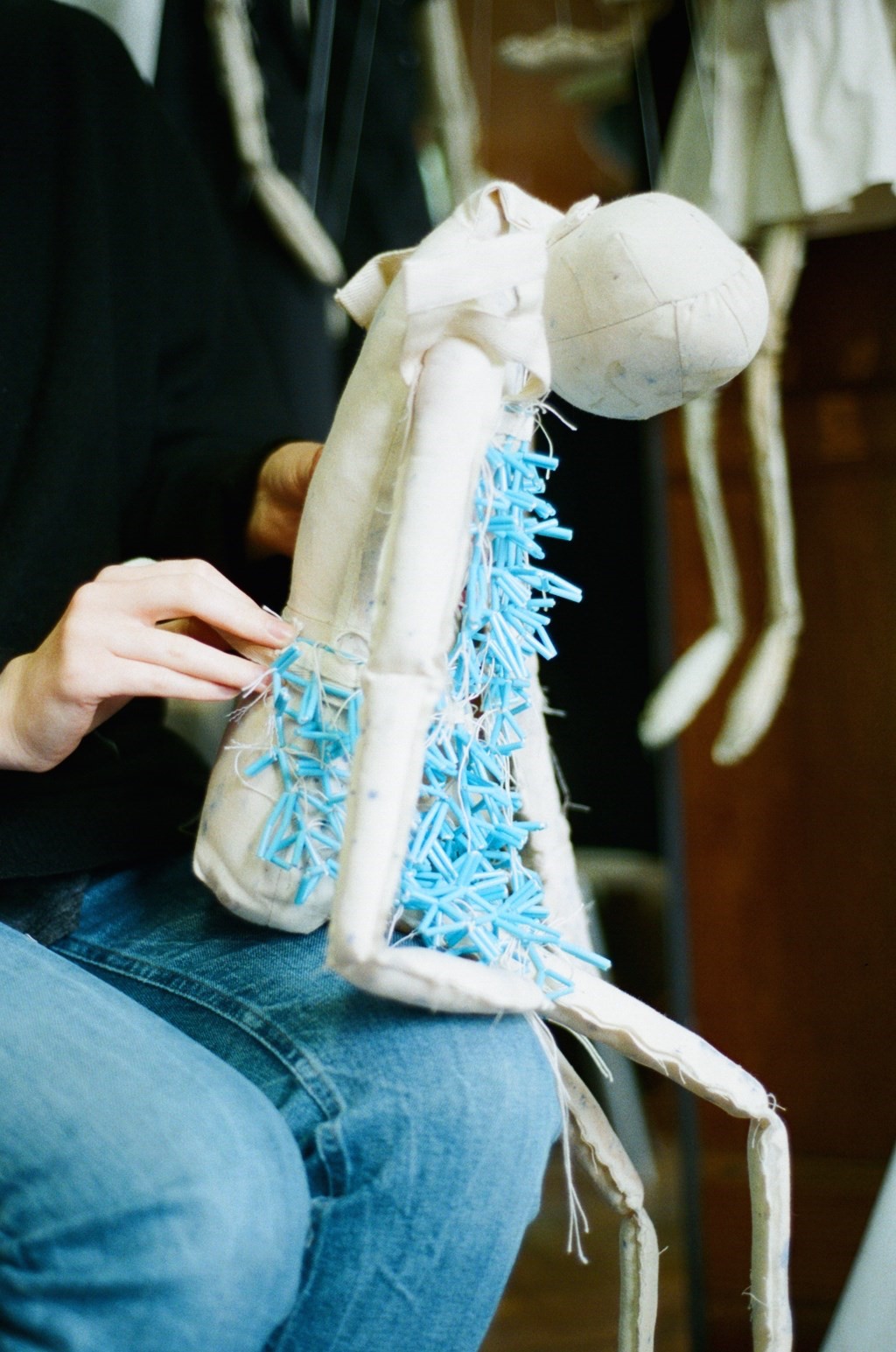

“I was quite taken aback [when the V&A invited me],” English recalls. “It was over a year ago and I was in Paris for sales. I had to go and find a quiet room to sit down! The V&A is a place that I’m really very fond of, and a lot of my realisations of what I wanted to do happened in that building. It was a very personal moment for me.”
Next came the process involved figuring out what a Phoebe English presentation might look like in this environment. Setting, she explains, tends to play a formative role in how she designs each collection. “I really struggle to design a collection if I don’t know the space or the room I’ll be showing it in. It has to develop as a whole thing. If we haven’t found a show venue it’s a nightmare, because I can’t start designing if I can’t see how it will be.” For the V&A, she looked back at her womenswear archive to see what she might bring to the show. “It was a bit of a bizarre experience. Like being in a time capsule. There are so many things I’d forgotten about, or that I look at now and think, ‘Ugh, why did I do that?’ There are some victories in there and there are some embarrassing things.”
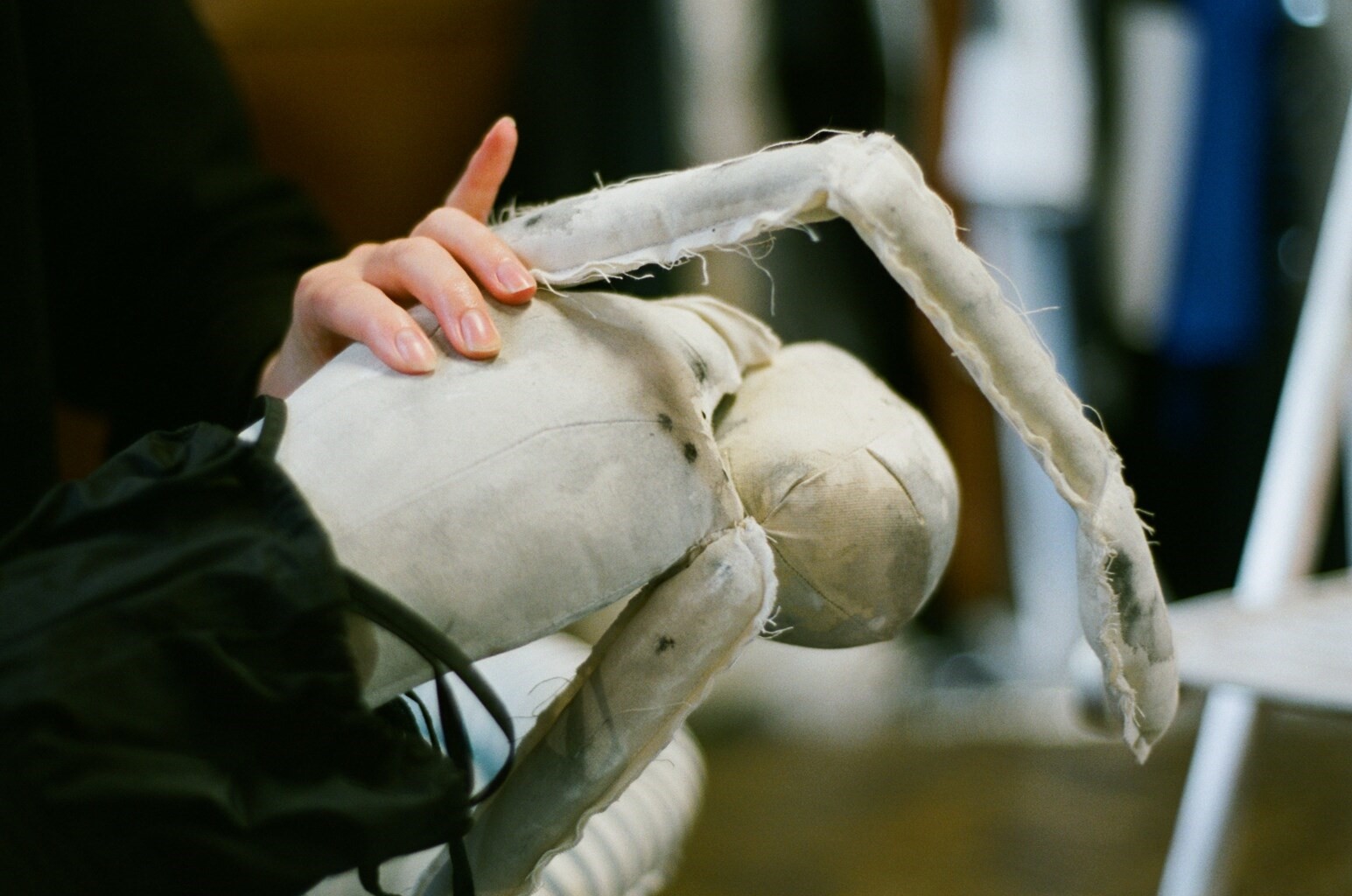
The puppets entered the picture after a chance meeting with a puppet-maker named Judith Hope who works from the same building as the designer. “I’m quite interested in serendipity as a way to lead the direction I’m going in. When I met her it was instant, and it was fascinating listening to her process.” Four puppets took part in the recent Spring 2018 presentation at London Fashion Week, and now they have grown into “an army of archive puppets,” English says with a laugh. “Judith went upstairs with an armful of sticks and wadding and fabric and came back downstairs a few hours later with this live creature. It really took me aback. It’s so strange, how people respond to it. I felt invasive, holding it and moving it. They take on this personification very quickly. Everyone started to refer to them as ‘her’.”
The process of making is integral to English’s vision. “There’s something very primal about doing something with your hands. In order to survive we made tools. The earliest human remains are found with made objects. It’s a part of who we are, even though there’s not very much need to make things now. It’s hard to artifically instigate some making time, but I do believe in its restorative abilities.”
“There’s something very primal about doing something with your hands. In order to survive we made tools. The earliest human remains are found with made objects. It’s a part of who we are” – Phoebe English

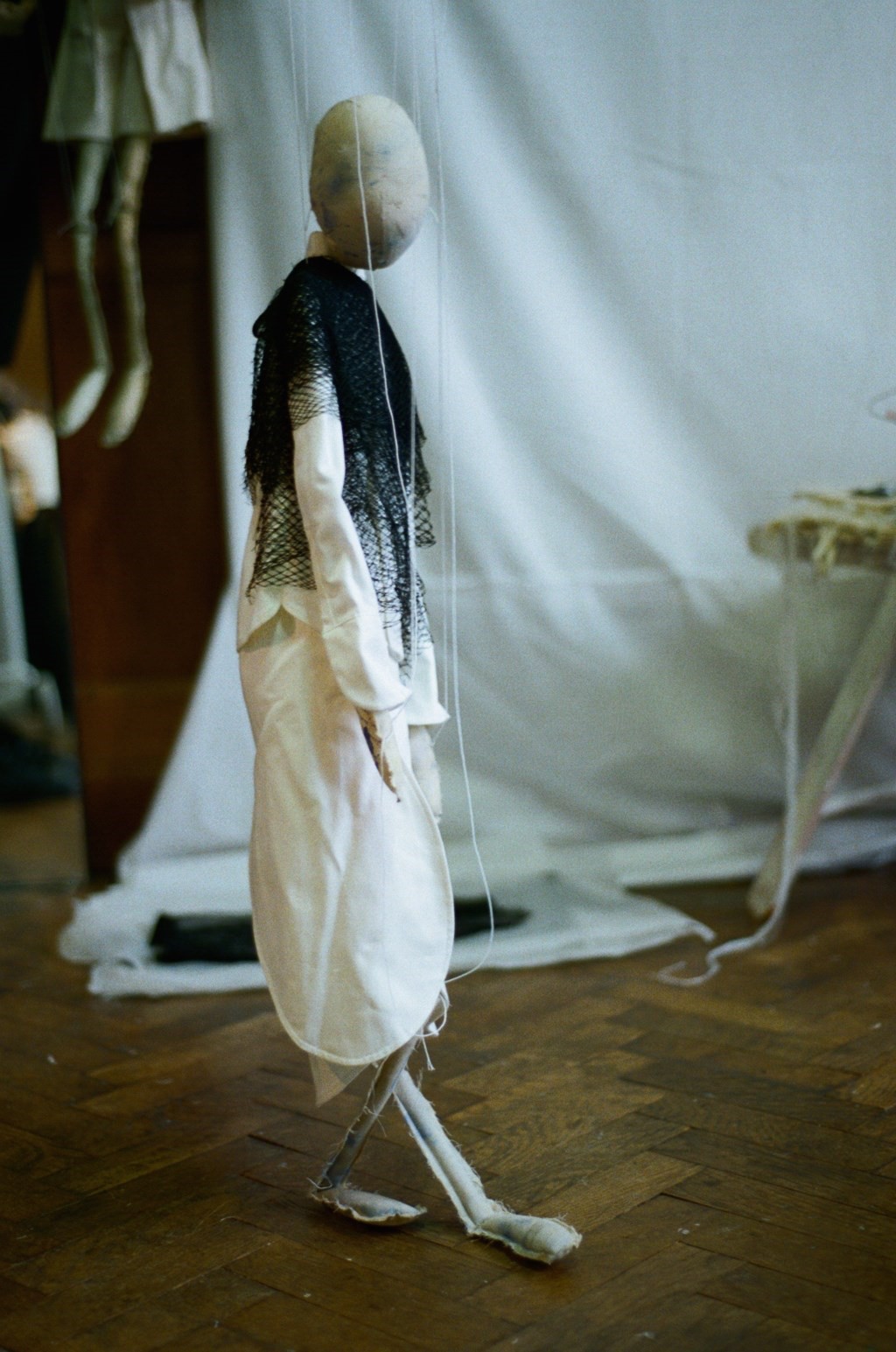
English doesn’t seem so interested in hitting the traditional career markers of the emerging designer – there are no sign of high street collaborations, or stints as director of a storied European house. Instead she has formed a path entirely of her own, one perhaps best characterised by her decision to use only English factories, most of them in the greater London area. That ‘Made in England’ tag on her clothes becomes a sign of her commitment to her own vision. “Once you start getting bigger, the margins do make it more sensible to ship it elsewhere, but for me it’s easier, it makes sense.”
Reviewers are often quick to position English’s work in a political framework. “I wonder where that comes from, since I never put it in the press release!” she exclaims. “But it’s very hard not to be political these days.” Brexit is already causing anxiety, as it threatens the quiet calm English has carefully created in her own work. But overall, she admits she’s not one for planning ahead too much. “With fashion, there’s such a pace to it that you never notice time passing,” she says, looking out the window. “I’ve never really had a plan. It’s just little things: trying your best each time and then responding to the outcome, which is hopefully good. Sometimes it’s bad, sometimes it’s good. If you want to carry on, you just have to carry on, if you can. That’s basically my business plan.”

Fashion in Motion: Phoebe English is taking place on October 20, 2017, at the V&A Museum, London.
